steering wheel KIA QUORIS 2017 Owners Manual
[x] Cancel search | Manufacturer: KIA, Model Year: 2017, Model line: QUORIS, Model: KIA QUORIS 2017Pages: 514, PDF Size: 35.2 MB
Page 13 of 514
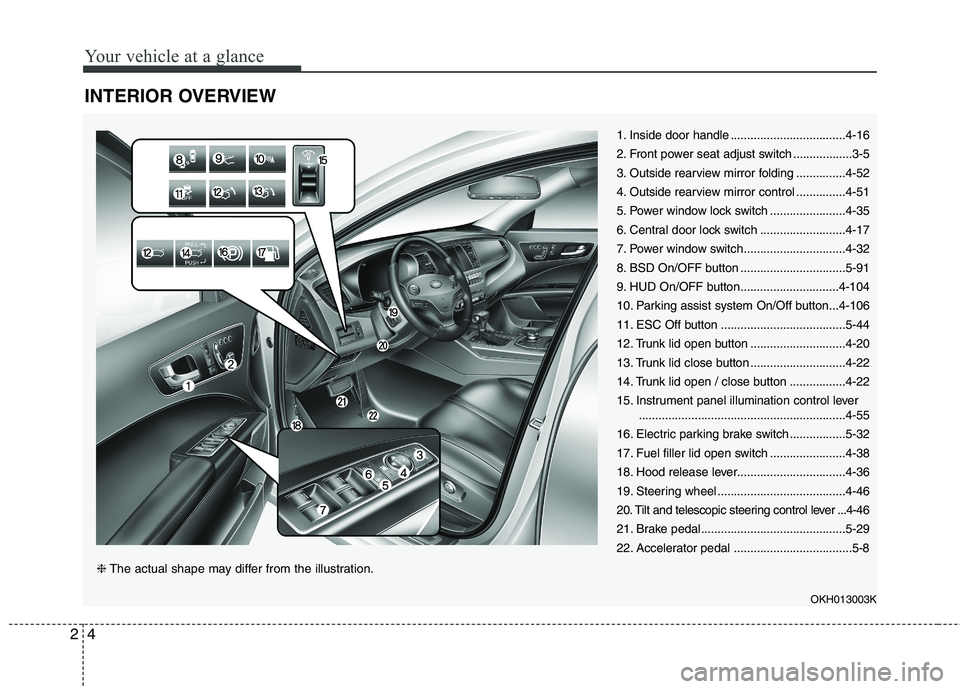
Your vehicle at a glance
4
2
INTERIOR OVERVIEW
1. Inside door handle ...................................4-16
2. Front power seat adjust switch ..................3-5
3. Outside rearview mirror folding ...............4-52
4. Outside rearview mirror control ...............4-51
5. Power window lock switch .......................4-35
6. Central door lock switch ..........................4-17
7. Power window switch...............................4-32
8. BSD On/OFF button ................................5-91
9. HUD On/OFF button..............................4-104
10. Parking assist system On/Off button...4-106
11. ESC Off button ......................................5-44
12. Trunk lid open button .............................4-20
13. Trunk lid close button .............................4-22
14. Trunk lid open / close button .................4-22
15. Instrument panel illumination control lever
...............................................................4-55
16. Electric parking brake switch .................5-32
17. Fuel filler lid open switch .......................4-38
18. Hood release lever.................................4-36
19. Steering wheel .......................................4-46
20. Tilt and telescopic steering control lever ...4-46
21. Brake pedal............................................5-29
22. Accelerator pedal ....................................5-8
OKH013003K
❈The actual shape may differ from the illustration.
Page 15 of 514
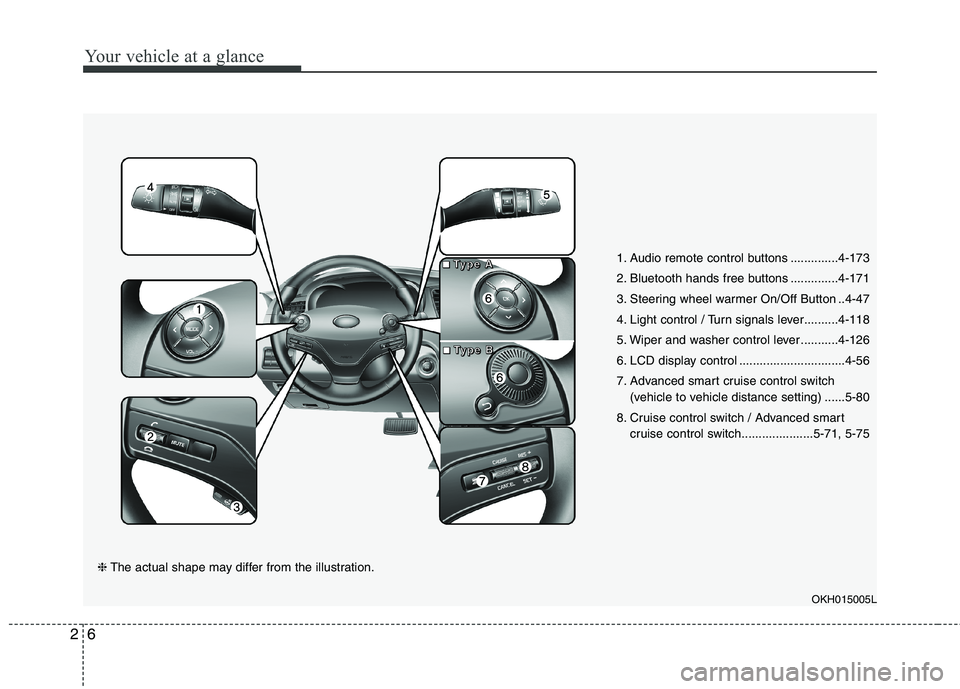
Your vehicle at a glance
6
2
1. Audio remote control buttons ..............4-173
2. Bluetooth hands free buttons ..............4-171
3. Steering wheel warmer On/Off Button ..4-47
4. Light control / Turn signals lever..........4-118
5. Wiper and washer control lever ...........4-126
6. LCD display control ...............................4-56
7. Advanced smart cruise control switch
(vehicle to vehicle distance setting) ......5-80
8. Cruise control switch / Advanced smart cruise control switch.....................5-71, 5-75
OKH015005L
❈The actual shape may differ from the illustration.
■■■■TTTTyyyyppppeeee AAAA
■■■■TTTTyyyyppppeeee BBBB
Page 21 of 514
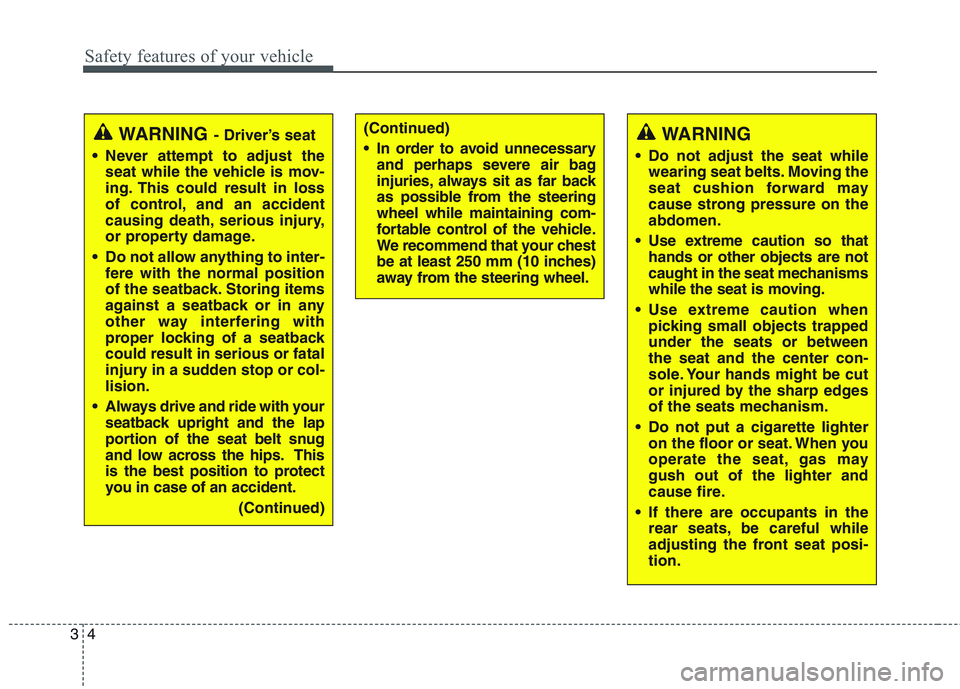
Safety features of your vehicle
4
3
WARNING
Do not adjust the seat while wearing seat belts. Moving the
seat cushion forward may
cause strong pressure on theabdomen.
Use extreme caution so that hands or other objects are not
caught in the seat mechanisms
while the seat is moving.
Use extreme caution when picking small objects trappedunder the seats or betweenthe seat and the center con-
sole. Your hands might be cut
or injured by the sharp edges
of the seats mechanism.
Do not put a cigarette lighter on the floor or seat. When you
operate the seat, gas maygush out of the lighter and
cause fire.
If there are occupants in the rear seats, be careful while
adjusting the front seat posi-tion.(Continued)
In order to avoid unnecessaryand perhaps severe air bag
injuries, always sit as far back
as possible from the steeringwheel while maintaining com-
fortable control of the vehicle.
We recommend that your chest
be at least 250 mm (10 inches)
away from the steering wheel.WARNING - Driver’s seat
Never attempt to adjust the seat while the vehicle is mov-
ing. This could result in loss
of control, and an accident
causing death, serious injury,
or property damage.
Do not allow anything to inter- fere with the normal position
of the seatback. Storing items
against a seatback or in any
other way interfering with
proper locking of a seatbackcould result in serious or fatal
injury in a sudden stop or col-lision.
Always drive and ride with your seatback upright and the lap
portion of the seat belt snug
and low across the hips. This
is the best position to protect
you in case of an accident.
(Continued)
Page 22 of 514
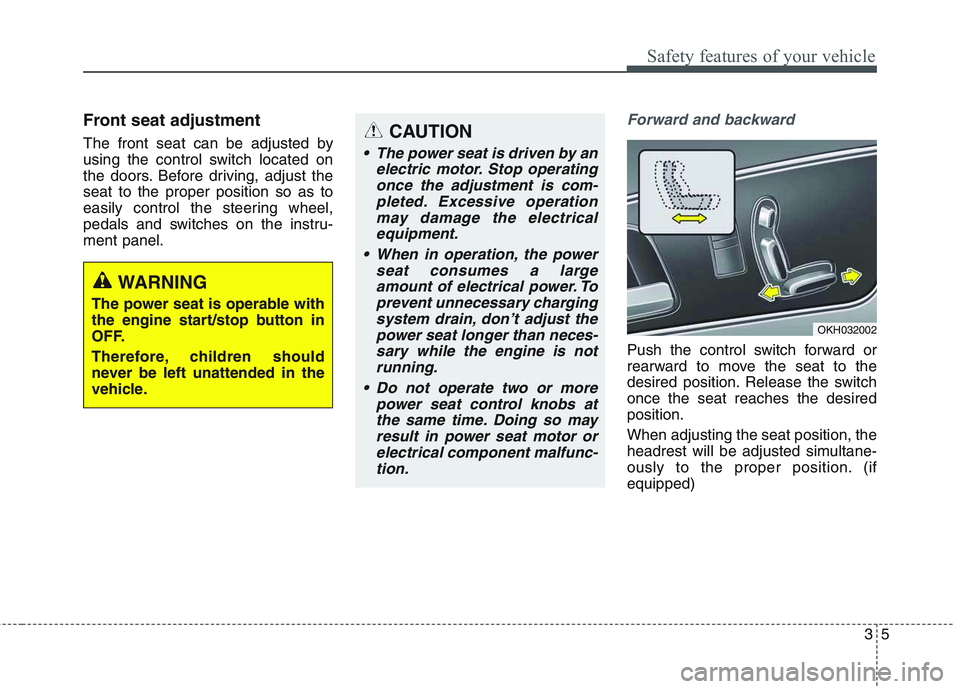
35
Safety features of your vehicle
Front seat adjustment
The front seat can be adjusted by
using the control switch located on
the doors. Before driving, adjust theseat to the proper position so as to
easily control the steering wheel,
pedals and switches on the instru-ment panel.Forward and backward
Push the control switch forward or
rearward to move the seat to the
desired position. Release the switchonce the seat reaches the desiredposition. When adjusting the seat position, the
headrest will be adjusted simultane-
ously to the proper position. (ifequipped)
CAUTION
The power seat is driven by anelectric motor. Stop operatingonce the adjustment is com- pleted. Excessive operationmay damage the electricalequipment.
When in operation, the power seat consumes a largeamount of electrical power. Toprevent unnecessary chargingsystem drain, don’t adjust the power seat longer than neces-sary while the engine is notrunning.
Do not operate two or more power seat control knobs atthe same time. Doing so mayresult in power seat motor orelectrical component malfunc- tion.
WARNING
The power seat is operable with
the engine start/stop button in
OFF.
Therefore, children should
never be left unattended in the
vehicle.
OKH032002
Page 24 of 514
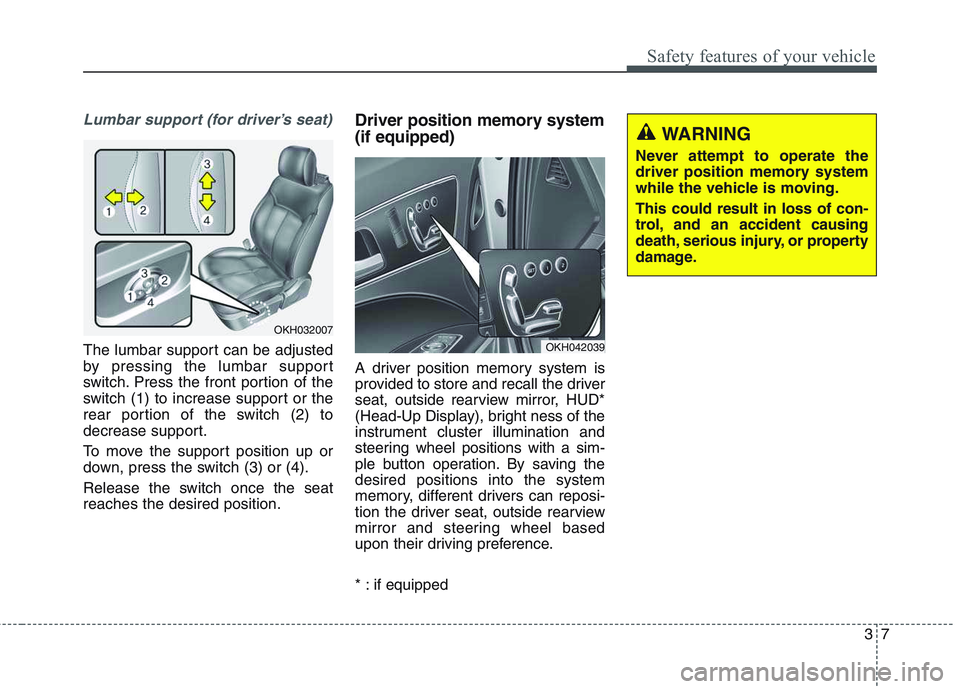
37
Safety features of your vehicle
Lumbar support (for driver’s seat)
The lumbar support can be adjusted
by pressing the lumbar support
switch. Press the front portion of the
switch (1) to increase support or the
rear portion of the switch (2) to
decrease support.
To move the support position up or
down, press the switch (3) or (4).
Release the switch once the seat reaches the desired position.Driver position memory system (if equipped)
A driver position memory system is
provided to store and recall the driver
seat, outside rearview mirror, HUD*
(Head-Up Display), bright ness of the
instrument cluster illumination and
steering wheel positions with a sim-
ple button operation. By saving thedesired positions into the system
memory, different drivers can reposi-
tion the driver seat, outside rearview
mirror and steering wheel based
upon their driving preference.
* : if equipped
OKH032007
OKH042039
WARNING
Never attempt to operate the
driver position memory system
while the vehicle is moving. This could result in loss of con-
trol, and an accident causing
death, serious injury, or property
damage.
Page 25 of 514

Safety features of your vehicle
8
3
Storing positions into memory
using the buttons on the door
Storing driver’s seat positions
1. Shift the shift lever into P while the engine start/stop button is ON.
2. Adjust the driver seat, outside rearview mirror, HUD* (Head-up
Display), bright ness of the instru-ment cluster illumination and
steering wheel to positions com-
fortable for the driver.
3. Press SET button on the control panel. The system will beep once.
4. Press one of the memory buttons (1 or 2) within 5 seconds after
pressing the SET button. The sys-tem will beep twice when the mem-
ory has been successfully stored. 5.
"Driver 1 (or 2) settings saved" will
appear on the LCD display.
* : if equipped Recalling positions from memory
1. Shift the shift lever into P while the
engine start/stop button is ON.
2. To recall the position in memory, press the desired memory button
(1 or 2). The system will beep
once, then the driver seat, outside
rearview mirror and steeringwheel will automatically adjust to
the stored positions.
3.
"Driver 1(or 2) settings is applied" will
appear on the LCD display.
Adjusting one of the control knobs for
the driver seat, outside rearview mir-
ror and steering wheel while the sys-tem is recalling the stored positions
will cause the movement for that
component to stop and move in thedirection that the control knob is
moved. Other components will con-
tinue to the recalled position.
OKH045570L/OKH045571L
OKH045568L/OKH045569L
Page 26 of 514
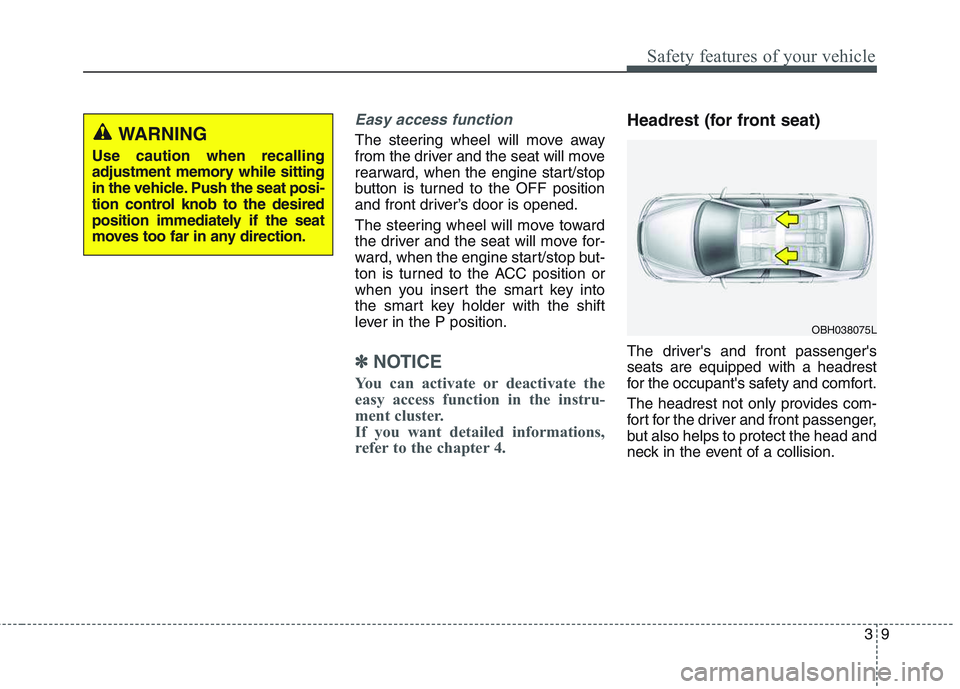
39
Safety features of your vehicle
Easy access function
The steering wheel will move away
from the driver and the seat will move
rearward, when the engine start/stop
button is turned to the OFF position
and front driver’s door is opened.
The steering wheel will move toward
the driver and the seat will move for-
ward, when the engine start/stop but-
ton is turned to the ACC position or
when you insert the smart key into
the smart key holder with the shift
lever in the P position.
✽✽NOTICE
You can activate or deactivate the
easy access function in the instru-
ment cluster.
If you want detailed informations,
refer to the chapter 4.
Headrest (for front seat)
The driver's and front passenger's seats are equipped with a headrest
for the occupant's safety and comfort.
The headrest not only provides com-
fort for the driver and front passenger,
but also helps to protect the head and
neck in the event of a collision.WARNING
Use caution when recalling
adjustment memory while sitting
in the vehicle. Push the seat posi-
tion control knob to the desired
position immediately if the seat
moves too far in any direction.
OBH038075L
Page 67 of 514

Safety features of your vehicle
50
3
There are even circumstances
under which contact with the
steering wheel air bag can cause
fatal injuries, especially if the
occupant is positioned exces-
sively close to the steering wheel.Noise and smoke
When the air bags inflate, they make
a loud noise and they leave smoke
and powder in the air inside of the
vehicle. This is normal and is a result
of the ignition of the air bag inflator.
After the air bag inflates, you may
feel substantial discomfort in breath-
ing due to the contact of your chestwith both the seat belt and the air
bag, as well as from breathing the
smoke and powder. Open your
doors and/or windows as soon as
possible after impact in order to
reduce discomfort and prevent
prolonged exposure to the smoke
and powder.
Though the smoke and powder are
non-toxic, they may cause irritation
to the skin (eyes, nose and throat,
etc). If this is the case, wash and
rinse with cold water immediatelyand consult a doctor if the symptom
persists.WARNING
To avoid severe personal injury or death caused by
deploying air bags in a colli-
sion, the driver should sit as
far back from the steering
wheel air bag as possible (at
least 250 mm (10 inches)
away). The front passengers
should always move their
seats as far back as possible
and sit back in their seat.
Air bags inflate instantly in the event of collision, and passen-
gers may be injured by the air
bag expansion force if they are
not in a proper position.
Air bag inflation may cause injuries including facial or
bodily abrasions, injuries
from broken glasses or burns.
Page 68 of 514

351
Safety features of your vehicle
Do not install a child restraint onthe front passenger’s seat.
Never place a rear-facing child
restraint in the front passenger’s
seat. If the air bag deploys, it would
impact the rear-facing child restraint,
causing serious or fatal injury. In addition, do not place front-facing
child restraints in the front passen-
ger’s seat either. If the front passen-
ger air bag inflates, it could cause
serious or fatal injuries to the child.
OYDESA2042
OLM034310
■
Type A
■Type B
WARNING
When the air bags deploy, the air bag related parts in the steering wheel and/or instru-ment panel and/or in both
sides of the roof rails above
the front and rear doors are
very hot. To prevent injury, do
not touch the air bag storage
area’s internal components
immediately after an air baghas inflated.
Do not install or place any accessories near air bag
deployment areas, such as
the instrument panel, win-
dows, pillars, and roof rails.
Page 71 of 514

Safety features of your vehicle
54
3
The front air bag modules are locat-
ed in the center of the steeringwheel, in the front passenger's panel
above the glove box and/or in the dri-
ver’s side knee bolster. When the
SRSCM detects a sufficiently severe
impact to the front of the vehicle, it
will automatically deploy the front air
bags. Upon deployment, tear seams mold-
ed directly into the pad covers will
separate under pressure from the
expansion of the air bags. Further
opening of the covers then allows full
inflation of the air bags.
A fully inflated air bag, in combina-
tion with a properly worn seat belt,
slows the driver's or the passenger's
forward motion, reducing the risk of
head and chest injury. After complete inflation, the air bag
immediately starts deflating,
enabling the driver to maintain for-
ward visibility and the ability to steer
or operate other controls.
OHM039103N
■
Driver’s front air bag (2)
OHM039104N
■Driver’s front air bag (3)
OHM039102N
■Driver’s front air bag (1)